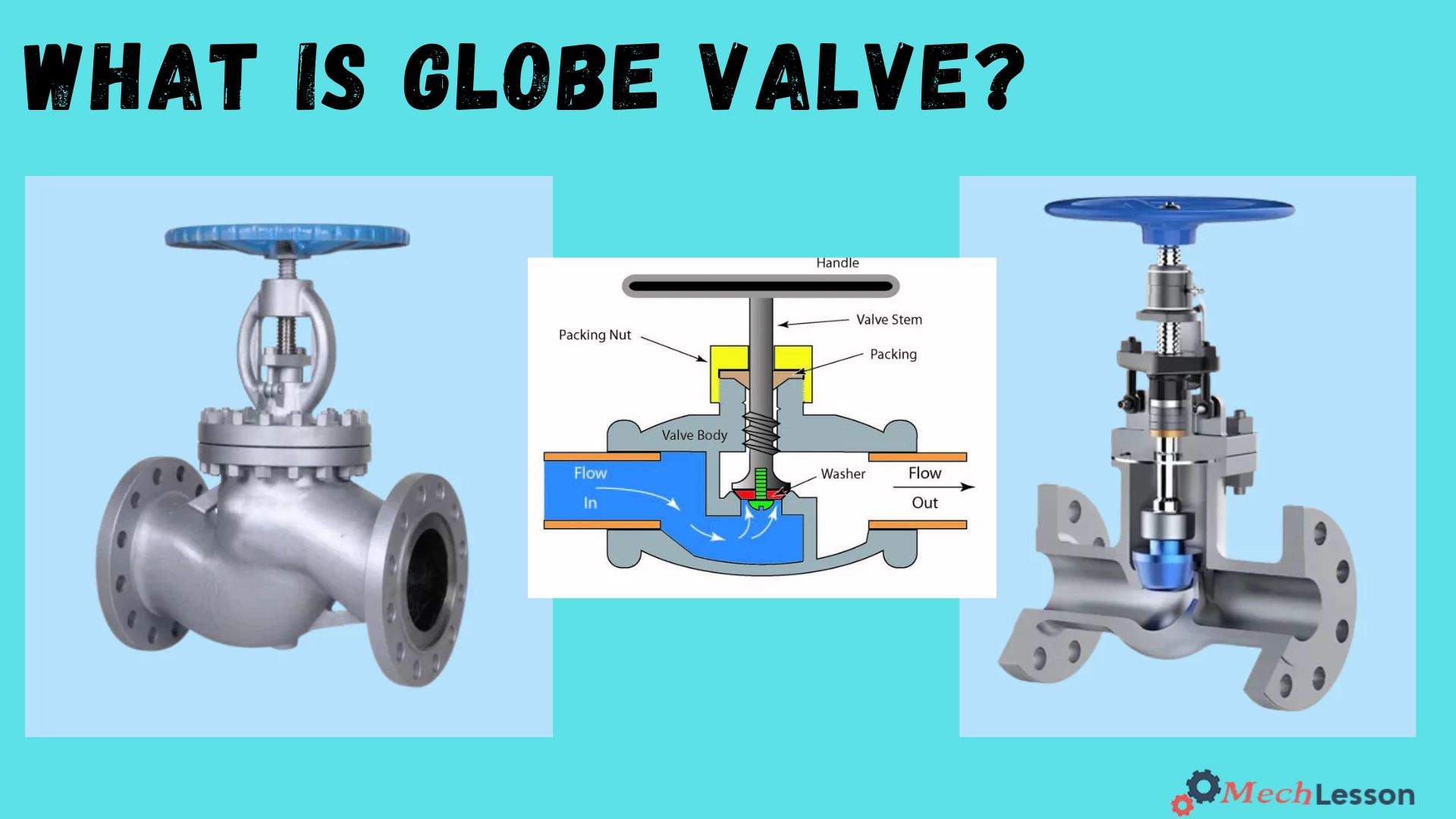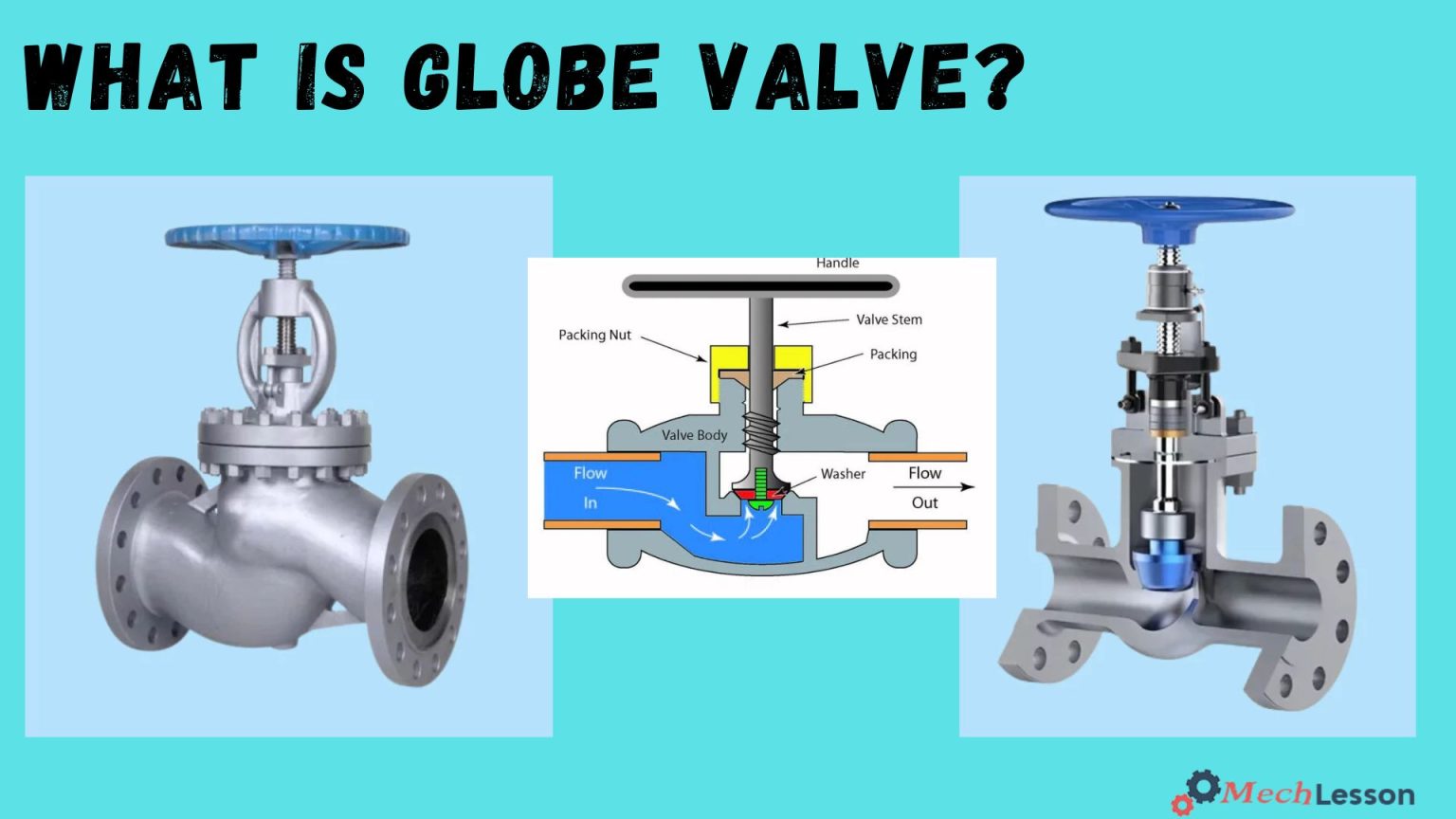Globe valves work effectively in situations where flow control is necessary. The globe valve has good sealing properties because the stem can effectively manage the seating load.
In contrast to a ball valve, a globe valve is a type of valve used to control pipeline flow. It consists of a fixed ring seat and a movable plug or disc element in a usually spherical body. Well, in this reading, we’ll explore a globe valve, its applications, parts, diagrams, how it works, advantages, and disadvantages.
Let’s begin!
You should learn about EGR Valve with this detailed guide!
What is a Globe Valve?
A globe valve is a type of valve used for regulating flow in a pipeline, consisting of a movable plug or disc element and a stationary ring seat in a generally spherical body.
it is one tool for controlling and/or preventing fluid flow in a pipeline, and it functions by stopping a fluid’s passage through a pipe. The term “globe” originated from the cylindrical shape of the valve.
The globe valve’s body is divided into two halves and is kept apart by an internal baffle.
Globe valves can be used in situations where the pressure drop through the valve cannot control the element, despite the fact that they show larger pressure dips than gate valves. When globe valves are used for throttling, they are also known as throttle valves.
Applications
The uses of globe valves are very common in today’s applications, as they are used for regulating the flow pressures and also complete shutoff of flow.
This is why they are ideal in cooling water systems, fuel oil systems, boiler and main steam vents, and drains. Globe valves are also used in turbine lube oil systems and feedwater or chemical feed systems, among others.
Furthermore, globe valves are sometimes used as pressure relief valves or as check valves. This is because they offer higher pressure loss in a fully open position. They are primarily used in a basic water faucet.
Many industries, like the aerospace, food, and medical industries, make good use of this valve.
You should also learn about Diaphragm Valve with this detailed guide!
Parts of Globe Valve
The major components in a globe valve include
- Valve Body
- Wheel and Nut
- Disc/Valve
- Valve/Disc Seat
- Gland Packing
- Stem
- Bonnet
Valve Body
The body is the primary component of the valve that contains pressure and is the easiest to identify because it makes up the majority of the valve. This includes the internal part of the valve that will come in contact with the material it is controlling.
The fluid, gas, or slurry that is controlled is contained by the bonnet that is attached to the body.
Wheel and Nut
A handwheel and crank are used to open or shut the valve on a manual or hand-operated actuator. This allows the operator to adjust the valve’s position when needed, although they are not automated.
The valve may be hammered open or closed as needed by attaching the handwheel to a stem or hammer.
Disc/Valve
One of the most important components of a globe valve is the disc or plug. Because it functions as a movable physical barrier, it may restrict or liberate the flow when it travels perpendicular to the seat.
The plug blocks the flow when the valve is closed by pressing on the seat; when it is above the seats, it permits the material to flow.
Valve/Disc Seat
The seat ring offers a consistent, stable, and interchangeable shut-off surface. Typically, seats are torqued or screwed in. This securely fastens the cage to the valve body by pressing it against the seat’s lip.
Another option is to thread and screw the seat into a thread cut in the same body part.
Gland Packing
A gasket is also known as valve packing; it creates a strong seal between the valve’s stem and bonnet. It is used to stuff boxes and valve stems to stop liquid leakage. The gland followers in the valves are tightened until the valve is able to stop leaks.
While tight packing impairs valve movement and may result in stem damage, loose packing causes leaks.
Stem
The stem in the system helps to transfer the actuation force from the disc to the handwheel or valve actuator. It is one of the crucial globe valve components because it joins the actuator to the internal components.
The stem of the manual valves is threaded, whereas the stem of the actuator-controlled valves is smooth.
Bonnet
Bonnet is one of the outside globe valve components that is attached to the body to produce a leak-proof seal. Various globe valves employ different types of bonnets, including union, screw-in, and bolted bonnets. Every one of these bonnet varieties offers unique benefits.
You should learn about Gate Valve with this detailed guide!
Diagram

Types of Globe Valve
Globe valve types are tee, angle, and wye. These are the common body setups.
1. Tee – this globe valve body type is most frequently used. The stem and disk can move perpendicular to the horizontal line when the seat is positioned horizontally. This design has the biggest pressure drop and the lowest coefficient of flow.
They are employed in bypass lines surrounding a control valve and other severe throttling applications. This globe valve design works well when throttling is needed and pressure drop is not an issue.
2. Angle – this Globe valve allows fluid to flow in a single 90° rotation since its ends are at a 90° angle.
Because of its capacity to manage “the slugging effect,” which is a normal occurrence with pulsing flow, this valve is utilized in applications where there are periods of pulsating flow.
3. Wye – this kind is a substitute for the high-pressure drop that globe valves frequently have. When completely open, the seat and stem are at a 45° angle, which delivers the least amount of flow resistance and a straighter flow channel.
Throttling during seasonal or startup operations is a popular usage for this design.
You should learn about Check Valve with this detailed guide!
How Does a Globe Valve Work?
Globe valves can mean a wide variety of valve types. These valves could be control valves, isolation valves, or a completely different type. The globe, as previously said, refers to the valve body’s spherical shape.
Globe valves are primarily used to stop, start, and control the flow of gases and liquids in pipelines. It typically consists of a cylindrical body with a non-moving ring seat and a moveable disc-type component.
A disc or plug is used to close the globe valve’s opening, which is located in the middle of the pipe and adjacent to it. Globe valves can manage flow in both directions due to their structure.
Globe valves can refer to a wide variety of valve types. They could be control valves, isolation valves, or a completely different type of valve. The globe, as previously said, alludes to the valve body’s spherical form.
Globe valves are primarily used to stop, initiate, and control the flow of gases and liquids in pipelines. It typically consists of a cylindrical body with a non-moving ring seat and a moveable disc-type component.
A disc or plug is used to close the globe valve’s opening, which is located in the middle of the pipe and adjacent to it. Globe valves can manage flow in both directions due to their structure.
The disc in the system is raised or lowered when the handwheel is turned. The water supply is totally cut off if the disk is lowered to its lowest setting.
Nonetheless, the water flow is at its fastest when the disc is in its highest position. In larger industrial environments, an electronic actuator instead of a manual handle can be used to seal a globe valve.
Typically, a globe valve has a baffle within. The liquid is forced to shift course and pass through this barrier. As a result, the fluid cannot flow as freely, which lowers the valve’s pressure.
Slurries or thicker liquids that the baffle can obscure are incompatible with globe valves.
You should also learn about Butterfly Valve with this detailed guide!
Advantages and Disadvantages of a Globe Valve
Globe valves offer good shutoff capability and moderate to good throttling, with a shorter stroke compared to gate valves. Available in tee, wye, and angle patterns, it’s easy to machine or resurface seats and can be used as a stop-check valve.
However, it has higher pressure drops and requires greater force or a larger actuator to seat the valve. Throttling flow under the seat and shutting off flow over the seat.
You should learn about a PCV Valve with this detailed guide!
FAQs
What is a globe valve used for?
They can be used to control the flow rate, pressure, and direction of a wide range of fluids, from water and oil to steam and chemicals. Globe valves are also highly durable and reliable, with a simple design that makes them easy to install, maintain, and repair.
What is the difference between a gate valve and a globe valve?
Both gate valves and globe valves can operate as on/off valves. A gate valve is not meant to be used to throttle flow, but a globe valve can. Flow diverts within the globe valve and becomes parallel to the valve seat. This design makes globe valves efficient flow throttlers.
Why use a globe valve instead of a ball valve?
The choice between a globe valve and a ball valve depends on the specific needs of the application, but in general, for precise flow control, a globe valve is preferable, while for on/off operations or where a minimal pressure drop is desired, a ball valve is more suitable.
What are the three types of globe valves?
Globe valves can be differentiated into three types based on their body design: angle pattern globe valve, standard or T-pattern globe valve, and oblique or Y-pattern globe valve.

